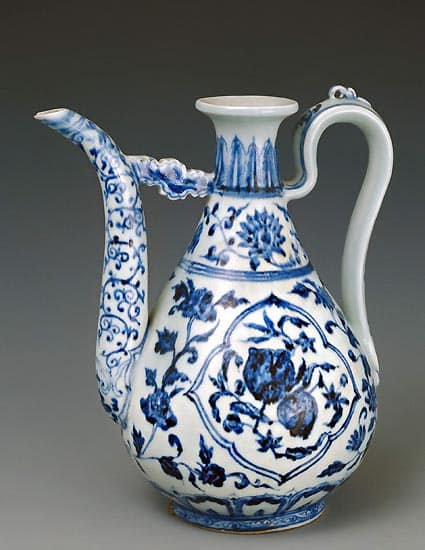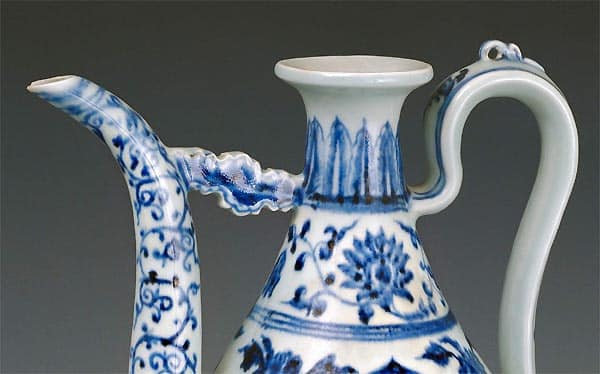Wine ewer decorated with flowers and fruits, Ming dynasty, Yongle period, 1403 - 1425
Wine ewer decorated with flowers and fruits, Ming dynasty, Yongle period, 1403 - 1425. Porcelain with underglaze blue decoration, height 26.1 cm, diameter of mouth 6.4 cm, National Museum of Chinese History, Beijing. © The Israel Museum.
Detail: spout. Wine ewer decorated with flowers and fruits, Ming dynasty, Yongle period, 1403 - 1425. Porcelain with underglaze blue decoration, height 26.1 cm, diameter of mouth 6.4 cm, National Museum of Chinese History, Beijing. © The Israel Museum.
Detail: decorations. Wine ewer decorated with flowers and fruits, Ming dynasty, Yongle period, 1403 - 1425. Porcelain with underglaze blue decoration, height 26.1 cm, diameter of mouth 6.4 cm, National Museum of Chinese History, Beijing. © The Israel Museum.
This wine ewer was made in Jingdezhen, the center of porcelain manufacture. It is based on an Islamic metal prototype.
During the Mongol Yuan dynasty, Islamic traders settled in China's coastal cities, and Muslim officials wielded considerable influence at the imperial court. Their fine metalwork spurred Chinese potters to copy many of these shapes in blue and white porcelain, sometimes decorated with Koranic texts. Ewers such as these are depicted on Persian miniatures as precious objects.
Chinese Muslims going on the hajj pilgrimage to Mecca would take along these blue and white porcelain wares to use as highly desirable objects of barter.
Exhibition 'China: One Hundred Treasures', Jerusalem, August 14, 2001 - January 15, 2002

/https%3A%2F%2Fprofilepics.canalblog.com%2Fprofilepics%2F1%2F0%2F100183.jpg)
/https%3A%2F%2Fstorage.canalblog.com%2F03%2F02%2F119589%2F96711876_o.jpg)
/https%3A%2F%2Fstorage.canalblog.com%2F11%2F31%2F119589%2F94773502_o.jpg)
/https%3A%2F%2Fstorage.canalblog.com%2F20%2F83%2F119589%2F94772815_o.jpg)
/https%3A%2F%2Fstorage.canalblog.com%2F26%2F72%2F119589%2F75604929_o.jpg)
/https%3A%2F%2Fstorage.canalblog.com%2F59%2F60%2F119589%2F26458628_o.jpg)





/image%2F1371349%2F20240417%2Fob_961e87_437772831-1653147868788559-54808306367.jpg)
/image%2F1371349%2F20240417%2Fob_cd839f_438802798-1652979072138772-16612847234.jpg)
/image%2F1371349%2F20240416%2Fob_3f6edc_438868891-1652442212192458-70192626099.jpg)
/image%2F1371349%2F20240416%2Fob_d2d582_438782719-1652440978859248-57071696236.jpg)